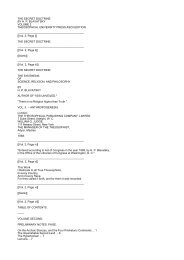You also want an ePaper? Increase the reach of your titles
YUMPU automatically turns print PDFs into web optimized ePapers that Google loves.
The Principal Geographical And Mythological Places In The <strong>Book</strong> Of The <strong>Dead</strong>.<br />
Sacred Texts Egypt Index Previous Next<br />
THE PRINCIPAL GEOGRAPHICAL AND<br />
MYTHOLOGICAL PLACES IN THE BOOK<br />
OF THE DEAD.<br />
Abtu, <strong>the</strong> Abydos <strong>of</strong> <strong>the</strong> Greeks (Strabo, XVII., i., 42), <strong>the</strong> capital <strong>of</strong> <strong>the</strong> eighth nome <strong>of</strong> Upper Egypt. It<br />
was <strong>the</strong> seat <strong>of</strong> <strong>the</strong> worship <strong>of</strong> Osiris, and from this fact was called Per-Ausar or Busiris, "<strong>the</strong> house <strong>of</strong><br />
Osiris "; <strong>the</strong> Copts gave it <strong>the</strong> name ###.[1] Egyptian tradition made <strong>the</strong> sun to end his daily course at<br />
Abydos, and to enter into <strong>the</strong> Tuat at this place through a "gap" in <strong>the</strong> mountains called in Egyptian<br />
peq.[2] These mountains lay near to <strong>the</strong> town; and in <strong>the</strong> XIIth dynasty it was believed that <strong>the</strong> souls <strong>of</strong><br />
<strong>the</strong> dead made <strong>the</strong>ir way into <strong>the</strong> o<strong>the</strong>r world by <strong>the</strong> valley which led through <strong>the</strong>m to <strong>the</strong> great Oasis,<br />
where some placed <strong>the</strong> Elysian Fields.[3]<br />
Amenta or Amentet, or was originally <strong>the</strong> place where <strong>the</strong> sun set, but subsequently <strong>the</strong> name was<br />
applied to <strong>the</strong> cemeteries and tombs which were usually built or hewn in <strong>the</strong> stony plateaus and<br />
mountains on <strong>the</strong> western bank <strong>of</strong> <strong>the</strong> Nile. Some believe that Amenta was, at first, <strong>the</strong> name <strong>of</strong> a small<br />
district, without ei<strong>the</strong>r funereal or mythological signification. The Christian Egyptians or Copts used <strong>the</strong><br />
word Amend to translate <strong>the</strong> Greek word Hades, to which <strong>the</strong>y attributed all <strong>the</strong> ideas which <strong>the</strong>ir<br />
hea<strong>the</strong>n ancestors had associated with <strong>the</strong> Amenta <strong>of</strong> <strong>the</strong> <strong>Book</strong> <strong>of</strong> <strong>the</strong> <strong>Dead</strong>.<br />
Annu, <strong>the</strong> Heliopolis <strong>of</strong> <strong>the</strong> Greeks (Herodotus, II., 3, 7, 8, 9, 59, 93; Strabo, XVII., I, 27 ff ), and <strong>the</strong><br />
capital <strong>of</strong> <strong>the</strong> thirteenth nome <strong>of</strong> Lower Egypt.<br />
[1. See Amélineau, la Géographie de l'Égypte, à l'Époque Copte, p. 155.<br />
2. See Brugsch, Dict. Géog., p. 227.<br />
3. See Maspero, Études de Mythologie, t. i., p. 345.]<br />
{p. cxxxiv}<br />
The Hebrews called it On (Genesis xli., 45, 50; xlvi., 20), Aven (Ezekiel xxx., 17), and Bêth-Shemesh<br />
(Jeremiah xliii., 13); this last name is an exact translation <strong>of</strong> <strong>the</strong> Egyptian per Ra, "house <strong>of</strong> <strong>the</strong> sun,"<br />
which was also a designation <strong>of</strong> Annu. The Copts have preserved <strong>the</strong> oldest name <strong>of</strong> <strong>the</strong> city under <strong>the</strong><br />
form ###.[1] A Coptic bishop <strong>of</strong> this place was present at <strong>the</strong> Council <strong>of</strong> Ephesus. The city <strong>of</strong> Annu<br />
seems to have become associated with <strong>the</strong> worship <strong>of</strong> <strong>the</strong> sun in prehistoric times. Already in <strong>the</strong> Vth<br />
dynasty its priesthood had succeeded in gaining supremacy for <strong>the</strong>ir religious views and beliefs<br />
throughout Egypt, and from first to last it maintained its position as <strong>the</strong> chief seat <strong>of</strong> <strong>the</strong>ological learning<br />
in Egypt. The body <strong>of</strong> <strong>the</strong> Aged One, a name <strong>of</strong> Osiris, reposed in Annu, and <strong>the</strong>re dwelt <strong>the</strong> Eye <strong>of</strong><br />
Osiris. The deceased made his way to Annu, where souls were joined unto bodies in thousands, and<br />
where <strong>the</strong> blessed dead lived on celestial food for ever.<br />
An-rutf or Naarutf, is a section or door <strong>of</strong> <strong>the</strong> Tuat which lies to <strong>the</strong> north <strong>of</strong> Re-stau; <strong>the</strong> meaning <strong>of</strong><br />
http://www.sacred-texts.com/egy/ebod/ebod10.htm (1 <strong>of</strong> 4) [8/10/2001 11:24:04 AM]

















